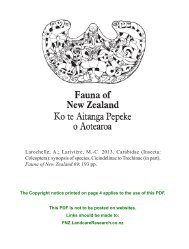Fauna of NZ 45 - Landcare Research
Fauna of NZ 45 - Landcare Research
Fauna of NZ 45 - Landcare Research
You also want an ePaper? Increase the reach of your titles
YUMPU automatically turns print PDFs into web optimized ePapers that Google loves.
<strong>Fauna</strong> <strong>of</strong> New Zealand <strong>45</strong> 49<br />
Table 1. Terminal taxa selected for phylogenetic<br />
analysis <strong>of</strong> Belinae (Belidae). Placement according<br />
to Alonso-Zarazaga & Lyal (1999).<br />
_____________________________________________<br />
Agnesiotidini<br />
Agathinus tridens (Fabricius)<br />
Agathobelus bivittatus Zimmerman<br />
Agnesiotis pilosula Pascoe<br />
Apagobelus brevirostris (Lea)<br />
Basiliobelus flavovittatus Zimmerman<br />
Cyrotyphus blandus (Faust)<br />
Cyrotyphus fascicularis Pascoe<br />
Cyrotyphus variegatus Lea<br />
Dicordylus binotatus (Philippi)<br />
Dicordylus marmoratus (Philippi)<br />
Macrobelus insignis Lea<br />
Belini<br />
Araiobelus filum (Jekel)<br />
Homalocerus lyciformis (Germar)<br />
Isacantha dermestiventris (Boisduval)<br />
Rhinotia bidentata (Donovan)<br />
Rhinotia haemoptera Kirby<br />
Stenobelus tibialis (Blackburn)<br />
Trichophthalmus miltomerus (Blanchard)<br />
Pachyurini<br />
Arhinobelus agathophagus Zimmerman<br />
Atractuchus annulifer (Philippi)<br />
Callirhynchinus exquisitus (Fairmaire & Germain)<br />
Hadrobelus undulatus (Zimmerman)<br />
Pachyura australis Hope<br />
Pachyurinus sticticus (Broun)<br />
Rhicnobelus aenescens (Broun)<br />
Rhicnobelus metallicus (Broun)<br />
Rhicnobelus rubicundus (Broun)<br />
Sphinctobelus cinereus (Blanchard)<br />
Palophaginae (Megalopodidae)<br />
Palophagus bunyae Kuschel<br />
_______________________________________<br />
(Kuschel and May 1990, 1996a,b). A total <strong>of</strong> 48 characters<br />
from adults <strong>of</strong> both sexes were scored for a cladistic analysis.<br />
The data were coded and entered into MacClade<br />
version 3 (Maddison and Maddison 1992) and analysed<br />
using PAUP* Version 4.0b8 for Macintosh (Sw<strong>of</strong>ford<br />
2001). The settings used in PAUP* for heuristic tree<br />
searches included a 100 random addition sequence with<br />
stepwise addition (holding 25 trees at each step) set with<br />
steepest descent; character states were treated as unordered;<br />
TBR branch swapping on all trees; and zero-length branches<br />
were collapsed. Polarity <strong>of</strong> character states was determined<br />
after the trees were produced. To further resolve<br />
relationships and find consistency for character congruence<br />
in these trees, successive approximations character<br />
weighting (SAW; Farris 1969; Carpenter 1988, 1994), an a<br />
posteriori weighting method, was performed on the resulting<br />
trees (weights were set at 10 and based on the consistency<br />
index with analyses truncated). Ambiguous characters were<br />
plotted onto trees using standard ACCTRAN and<br />
DELTRAN optimisations (Maddison et al. 1984) and in<br />
the discussion below, characters that reverse to other states<br />
are indicated by the superscript C r .<br />
Character list and argumentation<br />
1. Shape <strong>of</strong> temples in dorsal view. Converging caudad<br />
(0); parallel-sided or broadening caudad (1). This<br />
character is to be observed with the head in normal<br />
position, not extruded.<br />
2. Length <strong>of</strong> temples (t) to length <strong>of</strong> eyes (e). t = or < e (0);<br />
t > e (1). A usually unequivocal character, but is<br />
marginally distinct for Cyrotyphus and the Atractuchus/<br />
Dicordylus complex.<br />
3. Breadth <strong>of</strong> frons in relation to apex <strong>of</strong> rostrum. Equal<br />
or narrower (0); wider (1). The frons is the whole area<br />
between the eyes when viewed from above. The<br />
breadth <strong>of</strong> the frons is the minimum distance between<br />
the eyes Variations may be encountered, particularly<br />
in Cyrotyphus and the Atractuchus/Dicordylus complex,<br />
rendering a safe scoring somewhat difficult.<br />
4. Surface <strong>of</strong> frons in lateral view. Flat or convex (0);<br />
depressed (1). A depression at the front and base <strong>of</strong><br />
rostrum is ignored for coding this character. It is<br />
primitive if the frons above the middle is level or convex<br />
in relation to the upper margin <strong>of</strong> the eyes.<br />
5. Frontal carina. Absent (0); present (1). This character<br />
refers only to the presence <strong>of</strong> elongate, high carinae;<br />
consequently a small, inconspicuous carina sometimes<br />
present is not considered. This feature is exclusive <strong>of</strong><br />
Hadrobelus and Pachyura.<br />
6. Sides <strong>of</strong> frons near eyes. Lacking depressions (0); with<br />
superficial or well defined grooves (1). A superfical<br />
groove, longitudinal depression, or deep groove may<br />
be present on many beline taxa.<br />
7. Form <strong>of</strong> groove <strong>of</strong> frons near eyes. Shallow (0); deep<br />
(1); inapplicable for taxa coded as 6-0. A shallow<br />
superficial groove is a longitudinal, rather broad<br />
depression without sharp sides and with microsculpture<br />
at the bottom; a deeply engraved or incised groove is a<br />
narrow sulcus with sharply defined sides and a smooth,
















